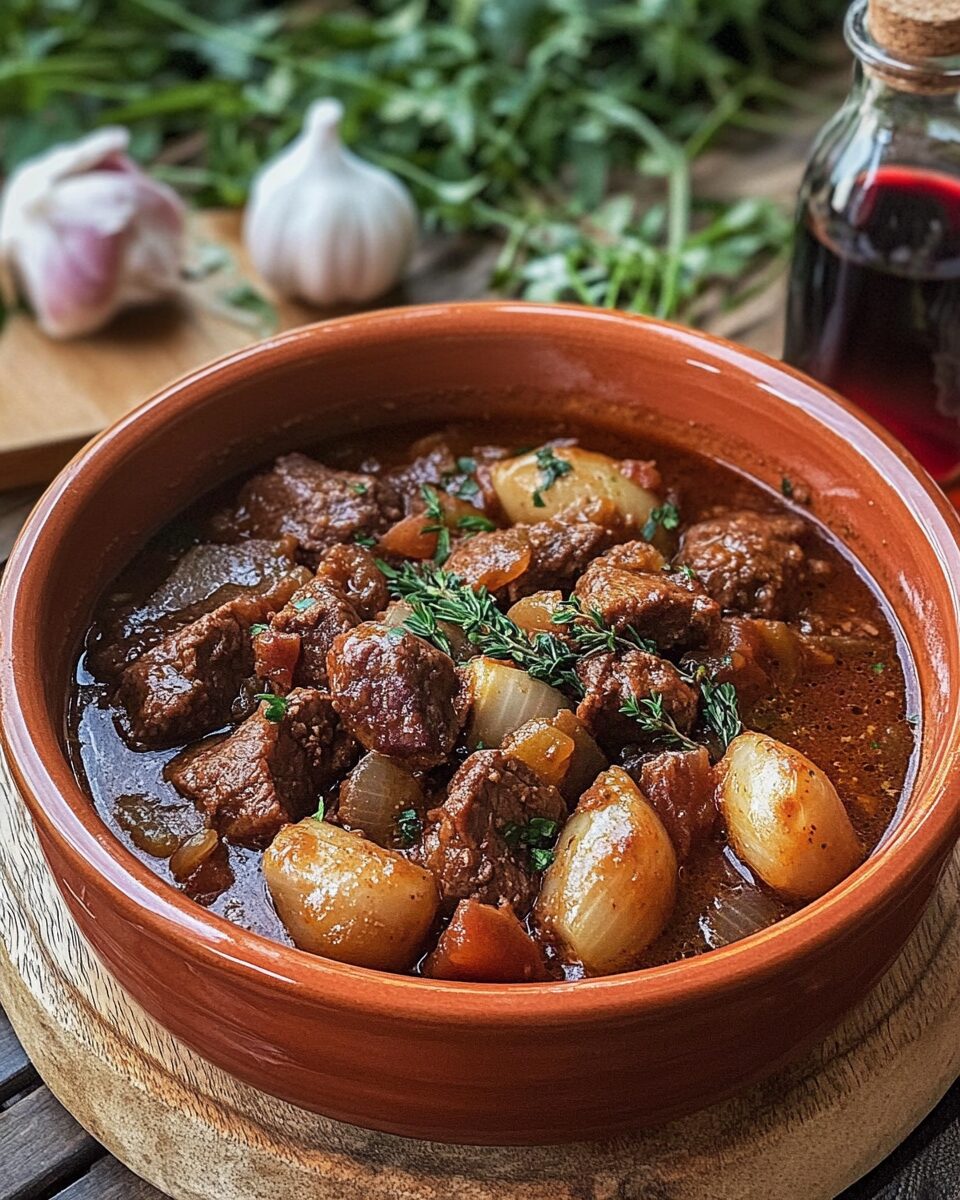Stifado is a traditional Greek beef stew known for its deep, rich flavors and comforting heartiness. Made with tender chunks of beef chuck, sweet shallots, and a tomato-based sauce spiced with cinnamon and cloves, this dish is perfect for cooler weather. The balance of savory, sweet, and warm spices makes it a signature Greek comfort food. Slow-cooked to perfection, it’s best enjoyed with crusty bread, rice, or mashed potatoes to soak up the flavorful sauce.
Full Recipe:
Ingredients
-
24 whole shallots, peeled
-
2¼ lbs beef chuck, cut into pieces
-
½ cup olive oil
-
4–6 garlic cloves, grated
-
2 tbsp red wine vinegar or balsamic vinegar
-
1 (28 oz / 794 g) can crushed tomatoes
-
1 tbsp tomato paste
-
1 tsp dried oregano
-
½ tsp sugar (adjust as needed)
-
2 bay leaves
-
4–6 whole peppercorns
-
1 cinnamon stick
-
2–3 whole cloves
-
Salt and pepper, to taste
-
1½ cups water
-
Pinch of red pepper flakes (optional)
Directions
1. Sauté the shallots:
Heat oil in a large pot over medium heat. Add the shallots and cook for 5–10 minutes until golden and softened. Remove and set aside.
2. Brown the beef:
In the same pot, brown the beef in two batches to avoid overcrowding. Sear each side for about 5 minutes until browned. Return all beef to the pot.
3. Build the sauce:
Add garlic and tomato paste to the beef. Cook briefly until fragrant. Stir in crushed tomatoes, vinegar, oregano, sugar, bay leaves, peppercorns, cinnamon stick, cloves, salt, pepper, and water.
4. Simmer the stew:
Bring to a boil, then reduce heat and simmer uncovered for 1 hour and 15 minutes, until beef is tender and the sauce has thickened.
5. Add shallots:
Carefully add the sautéed shallots to the stew. Gently shake the pot to distribute without breaking the onions. Simmer for another 30 minutes.
6. Serve:
Serve hot with mashed potatoes, rice, or rustic bread. Kali orexi (bon appétit)!
Nutrients (Estimated per serving, serves ~6)
-
Calories: ~480
-
Protein: ~32g
-
Fat: ~28g
-
Carbohydrates: ~18g
-
Fiber: ~3g
-
Sugar: ~8g
-
Sodium: Moderate (varies based on canned tomatoes and salt added)
A Time-Honored Dish with Byzantine Roots
Stifado’s origins are rooted in Greek antiquity, with its earliest versions said to date back to the Byzantine era. The word “stifado” is believed to derive from the Italian stufato, meaning stewed or braised, a nod to historical Venetian influences on Greek cuisine. Over time, the dish evolved into its distinctive Greek version, where spices like cinnamon and cloves replaced the heavier wine-based sauces of other Mediterranean stews.
What sets Stifado apart from other beef stews is its inclusion of whole shallots and warm spices. The shallots become sweet and tender as they simmer, while spices infuse the meat and sauce with unmistakable Greek character. It’s this combination of sweet and savory, bold and mellow, that makes every bite of Stifado both unique and unmistakably Mediterranean.
The Flavor Profile: Deep, Sweet, and Spiced
The rich, tomato-based sauce is at the heart of Stifado. Crushed tomatoes and tomato paste create a thick, velvety base that coats each piece of beef and shallot in tangy sweetness. The acidity from the tomatoes is mellowed by the gentle addition of sugar and a splash of vinegar—either red wine vinegar or balsamic—adding a subtle complexity that enhances the overall depth of the stew.
Warm spices like cinnamon sticks, whole cloves, and bay leaves elevate the flavor with aromatic earthiness. These ingredients don’t overpower the dish but rather add a lingering warmth that complements the tender beef and naturally sweet shallots. Dried oregano and whole peppercorns contribute herbal and peppery undertones, resulting in a dish that is balanced, rich, and unmistakably Greek.
The shallots, simmered whole, soak up all these flavors while maintaining their soft, silky integrity. Their natural sweetness counteracts the acidity and spice of the sauce, offering bursts of mellow, caramelized onion flavor throughout the stew.
A Slow Cooked Labor of Love
Stifado is not a dish you rush. It’s meant to simmer slowly on the stove, allowing each ingredient to develop and meld into a cohesive, flavorful whole. The beef is first seared to create a browned crust, locking in flavor and texture. Shallots are gently sautéed until golden, then added later in the process to avoid overcooking.
The long, slow simmer—typically over an hour and a half—breaks down the beef into fork-tender chunks that absorb the spiced tomato sauce. This method also allows the sauce to reduce and intensify, becoming thick enough to coat a spoon, yet luscious enough to spoon over rice or mashed potatoes.
Despite its luxurious flavor and rich texture, Stifado is a relatively simple dish to prepare. Most of the cooking is passive—letting the pot do the work while the flavors evolve. It’s the kind of dish that rewards patience and care, making it perfect for Sunday dinners or make-ahead meals.
Pairings and Serving Suggestions
While Stifado can be enjoyed on its own, it truly shines when paired with a complementary starch or bread to soak up the sauce. Creamy mashed potatoes are a favorite choice, their buttery texture harmonizing with the tangy, spiced sauce. Rice, especially a simple white rice or Greek-style pilaf, is another excellent accompaniment.
For a more rustic touch, thick slices of crusty country bread make for an ideal pairing. Use the bread to mop up the sauce, enjoying every last drop of flavor. Some also enjoy it with pasta, such as orzo or pappardelle, turning the stew into a rich meat sauce that clings to every noodle.
To round out the meal, a simple Greek salad with cucumber, tomato, olives, and feta offers a refreshing contrast to the rich main dish. A glass of dry red wine—such as a Xinomavro or Agiorgitiko—adds the perfect finishing touch, echoing the warm, spiced tones of the stew.
Tips for Making the Perfect Stifado
Using good-quality beef chuck is key, as this cut becomes meltingly tender with long, slow cooking. Be sure to brown the meat in batches to prevent steaming and to achieve that coveted seared crust.
Shallots should be peeled but left whole or halved if very large. Avoid slicing them too thin, as they may break down too much during cooking. Cooking them separately at the start and adding them later in the process helps preserve their structure and texture.
When adding the spices, remember that less is more. The cinnamon stick and cloves are powerful ingredients that infuse the dish with subtle depth but can quickly become overwhelming if overused. One cinnamon stick and two to three cloves are usually enough to flavor a whole pot.
The stew can be made a day in advance and reheated, as the flavors deepen over time. In fact, many Greek home cooks swear by eating Stifado the next day, when the beef is even more tender and the sauce has fully matured.
A Symbol of Greek Comfort and Hospitality
In Greek culture, food is more than sustenance—it’s an expression of love and hospitality. Stifado exemplifies this spirit. It’s the kind of meal that brings families together, fills the house with comforting aromas, and warms the body and soul. Whether served at a holiday table or on an ordinary evening, Stifado represents the heart of Greek cooking: bold flavors, honest ingredients, and a respect for tradition.
It’s also a dish that connects generations, with recipes handed down from grandparents to grandchildren, often with slight variations based on region or family preference. Some versions add carrots, chestnuts, or even rabbit instead of beef, but the core remains the same: a deeply flavorful stew that reflects the richness of Greek culinary tradition.
Conclusion
Stifado is a celebration of slow cooking and timeless flavor. With its tender beef, sweet caramelized shallots, and aromatic tomato sauce infused with warm spices, it offers everything you could want in a comfort dish. Rooted in tradition and bursting with character, it’s a stew that transports you to the sunlit kitchens of Greece with every bite.
Whether you’re discovering Greek cuisine for the first time or revisiting a beloved favorite, Stifado is a dish that leaves a lasting impression. Serve it with pride, share it with loved ones, and savor the journey it offers—one spoonful at a time.

